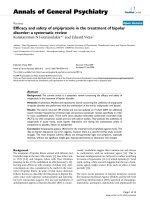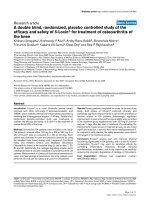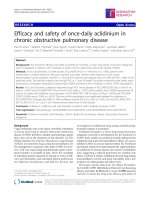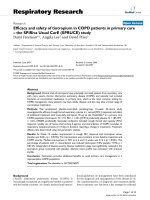Efficacy and safety of Vinflunine for advanced or metastatic urothelial carcinoma in routine practice based on the French multi-centre CURVE study
Bạn đang xem bản rút gọn của tài liệu. Xem và tải ngay bản đầy đủ của tài liệu tại đây (666.97 KB, 9 trang )
Médioni et al. BMC Cancer (2016) 16:217
DOI 10.1186/s12885-016-2262-9
RESEARCH ARTICLE
Open Access
Efficacy and safety of Vinflunine for
advanced or metastatic urothelial
carcinoma in routine practice based on the
French multi-centre CURVE study
Jacques Médioni1*, Mario Di Palma2, Aline Guillot3, Dominique Spaeth4 and Christine Théodore5
Abstract
Background: To retrospectively assess the efficacy and safety of Vinflunine (VFL) under routine conditions and
identify overall survival (OS) prognostic factors.
Methods: Twenty centres participated in the retrospective study (minimum 4 patients undergoing VFL treatment
for advanced/metastatic UC after platinum-based regimen progression. Primary endpoint was OS. Secondary
endpoints: progression-free survival (PFS), radiological response rate (RR) RECIST criteria and toxicity (CTC NCI v3).
Results: These centres enrolled 134 patients. Prior chemotherapy (CT) lines (≥1 palliative): 1 and ≥2 in 69 % and
26 % of patients, respectively. Performance status (PS): 0, 1, 2 in 25 %, 46 % and 23 % of patients. Median OS = 8.2 months
[6.5–9.4], PFS = 4.2 months and RR 22 %, median number of 5 cycles. In risk groups based on 0–3 presence of adverse
prognostic factors (PS ≥1, haemoglobin ≤10 g/dl and liver metastasis), median OS: 13.2, 9.9, 3.6, and 2.4 months
(P < .0001), respectively; 3.3 months (1.9–5.6) in PS ≥ 2 subgroup.
Conclusion: This study reflects routine UC management and confirmed VFL patient efficacy. The drug is safe with
gastro-intestinal and haematological prophylaxis. Analysis of prognostic factors for OS is consistent with pivotal trials.
Keywords: Vinflunine, Metastatic, Urothelial carcinoma, Chemotherapy, Routine, Platinum pre-treated, CURVE
(urothelial carcinoma patients treated by VinfluninE study-in French)
Background
Bladder cancer is a major health problem with an estimated 429,793 new cases and 165,068 related deaths in
2012, worldwide [1]. Transitional cell carcinoma of the
urothelium (TCCU) is of particular concern in Western
countries, with the highest incidence rates in Europe
and North America. In 2012, bladder cancer was the
fifth most frequent malignancy with 4,772 deaths in
France [2].
Recurrence of non–muscle-invasive urothelial carcinoma of the bladder is common despite treatment; low and
high grade tumours have recurrence rates of 50 %–70 %
* Correspondence:
This study was previously presented in part at the European Cancer
Congress (ESMO) in Amsterdam, September 10th, 2013.
1
Medical Oncology Department, Hôpital Européen Georges Pompidou, 20,
rue Leblanc, 75015 Paris, France
Full list of author information is available at the end of the article
and more than 80 %, respectively. Stage progression occurs in 15 %–20 % of non–muscle-invasive cases [3]. It is
a muscle-invasive disease with poor progression and survival. Patients have a significantly high risk for progression
to regional and systemic disease. Regardless of treatment,
the 5-year overall survival (OS) rate for patients is approximately 50 % [4]. For patients with metastatic disease,
a cisplatin-based combination is the standard first-line
treatment. However, approximately one patient out of two
is not fit enough to receive cisplatin therapy and the alternative is usually a carboplatin-based regimen or a single
agent. Median survival is approximately 14 months in
cisplatin-eligible patients and less than 10 months for unfit patients. Although initial response rates are high in
these patients, disease progression is common, creating a
number of patients in need of effective second-line
chemotherapy (CT) [5–7]. Until recently no standard of
© 2016 Médioni et al. Open Access This article is distributed under the terms of the Creative Commons Attribution 4.0
International License ( which permits unrestricted use, distribution, and
reproduction in any medium, provided you give appropriate credit to the original author(s) and the source, provide a link to
the Creative Commons license, and indicate if changes were made. The Creative Commons Public Domain Dedication waiver
( applies to the data made available in this article, unless otherwise stated.
Médioni et al. BMC Cancer (2016) 16:217
care was available for patients who failed a first systemic
chemotherapy regimen. Studies exploring potential clinical activity of anticancer agents are mainly limited to
non-randomized phase II trials without scientific evidence
assessing a clinical benefit over supportive care [6, 7].
Vinflunine (VFL), a novel microtubule inhibiting agent,
has been shown to be effective against a variety of solid
tumour types including advanced TCCU. In vivo, VFL has
shown to have a greater antitumor activity than other vinca
alkaloids [8, 9]. VFL is the first and only agent that has to
date been assessed in a randomised phase III trial in a
second-line setting, compared with best supportive care
(BSC). In fact, prior to the development of this agent, there
was neither an approved agent nor any established standard second-line therapy available in this setting. VFL plus
BSC achieved a 2.6 month overall survival (OS) advantage
in patients with advanced TCCU over BSC alone [10].
In Europe, VFL has been approved as a treatment
option for patients with advanced urothelial cancer who
failed a prior platinum-containing regimen [10–13]. VFL
was introduced in France in September 2010 and has
been integrated into the French and European guidelines
[6, 7, 14–16].
The first aim of the CURVE (“Carcinoma of the
Urothelium: patients treated by VinfluninE”) study was
to retrospectively assess the efficacy and safety of VFL in
second-line treatment for advanced or metastatic
urothelial carcinoma in daily routine practice. The secondary objective was to confirm whether the prognostic
factors for OS identified across the pivotal trials (performance status (PS), haemoglobin level and liver metastasis)
were relevant or not in routine practice as well as to
evaluate other possible prognostic factors for OS [17].
Methods
Data source
Eighty-eight French centres (i.e. private clinics, university hospitals, private hospitals) that had treated at least
four patients with VFL for advanced or metastatic cancer after failure of platinum-based (CT) during 2011
(January-December) were contacted and 22 centres
agreed to participate in the study. Prior written consent
was not required from patients according to French regulations as this was an anonymous non-interventional study.
Nevertheless, patients received complete information regarding the series and the anonymous collection of data for
research. If a patient refused participation, the registration
was not performed. Data were collected between December
2011 and March 2012.
Page 2 of 9
1- The Advisory Committee for the Treatment of Information – Ministry of Higher Education gave their
approval on the 17th September, 2012, Dossier N°
12.526. 2- The National Commission of Informatics
and Civil Liberty gave their approval on the 19th October,
2012 Decision DR-2012-504, authorization demand
N° 912480.
Characteristics of patients at the beginning of treatment therapy with VFL included age, performance status
(PS), metastatic sites (i.e. liver, bone, lung, skin and
brain), renal/liver function, relevant medical history i.e.
gastro-intestinal chronic disease, cardiac disease, or previous treatment. The disease history was recorded, as
well as, the number of previous treatment lines, regimen
and duration of prior CT. VFL treatment modalities
(starting dose, dose-escalation or reduction, number of
cycles), the haematological and non-haematological adverse events were also recorded [18] including reasons
for stopping treatment. Efficacy parameters i.e. response
rate (radiologic assessment considering RECIST 1.1),
progression-free survival and overall survival were included in the database.
Patient inclusion criteria
Only patients 18 or over, who had previously received a
single-agent therapy with VFL for advanced or metastatic TCCU after progression to a platinum-based CT
were enrolled in the study. Treatment with VFL was
administered from 01/01/11 to 31/12/11.
Assessment criteria efficacy
Primary endpoint was OS, i.e. time between treatment
start and date of last follow-up or death. Progressionfree survival was defined as the time between treatment
start and disease progression (defined as the appearance
of two or more lesions on a bone scan, or progression of
visceral metastases by computer tomography scan according to RECIST 1.1.) or death. Efficacy was also measured
using radiological response rate (complete response [CR] +
partial [PR] response, and disease control (CR + PR + Stable
Disease [SD]) were based on the RECIST 1.1 criteria.
Tolerance assessment
The following adverse events were routinely recorded:
neutropenia, febrile neutropenia, thrombocytopenia, anaemia, constipation, nausea/vomiting, infection, fever,
asthenia/fatigue, neuropathy, stomatitis, mucositis, and
abdominal pain. Other adverse events, based on a standard criteria were also recorded [18].
Ethics committee approval
Prognostic factors
French Government approval, in compliance with the
Helsinki Declaration, was received to use the patient
data for the French multi-centre CURVE study from:
Several potential pre-treatment prognostic factors for
OS were investigated in univariate/ multivariate analyses:
PS (0 or ≥1), previous history of pelvic radiotherapy,
Médioni et al. BMC Cancer (2016) 16:217
haemoglobin level (≤10 or >10 g/dl), creatinine clearance
(≤60 or >60 ml/min), liver function (abnormal or normal),
previous lines of CT (≤1 or >1), metastases at diagnosis,
visceral metastases, liver metastases, lung metastases,
previous treatment by cisplatin, previous treatment by
cisplatin versus carboplatin, progression free interval
before VFL (<6 or ≥6 months), previous surgery
(bladder or kidney/ureter).
Page 3 of 9
A scientific committee of the five authors controlled
protocol conditions and reviewed all data prior to statistical analysis.
Results
Data source
Among the eighty-eight centres contacted twenty (i.e.
50 % university hospital or cancer centres, 35 % private
clinics and 15 % private hospitals) agreed to participate
in the study with data collected from 134 patients.
Statistical analysis and quality control
Data were analysed (SAS system software version 9.3).
Descriptive methods were used to present the data:
quantitative variables were described either by mean
plus standard deviation, or median with the range of
values; qualitative variables were expressed by frequency
and percentages, confidence interval of 95 %.
Survival data univariate analysis was performed using
a log-rank test and multivariate analysis with a Cox proportional hazard model. Hazard ratios were estimated
using the Cox proportional hazard model.
Previous medical history of patients
In the intention to treat (ITT) population the sex ratio
(female/male) was 11.2/88.8, median age 65.3 [range
42.1-88.2] with patients ≥65 years and ≥ 75 years old
representing 52 % and 21 %, respectively. PS was 0 in 34
patients (25 %), 1 in 62 (46 %) and PS ≥ 2 in 31 (23 %);
information was missing for 7 patients. (Main Patients
Characteristics see: Table 1.)
All patients received prior chemotherapy, with the majority (95.5 %) for advanced or metastatic disease.
Table 1 Patients characteristics and potential prognostic factors
ITT population
N = 134
Gender (%) F/ M
15 (11.2)/119 (88.8)
Median Age (years, min/max)
65.3 [42.1–88.2]
[35–50 [N (%)
7 (5.2)
[50–65 [N (%)
57 (42.5)
[65–75 [N (%)
42 (31.3)
≥75 N (%)
28 (20.8)
Performance Status N (%)
0/1/ ≥ 2/Na
34 (25.4)/62 (46.3)/31 (23.1)/7 (5.2)
Metastases N (%)
Lung/Liver/Bone/Lung + Liver/Other
52 (38.8)/38 (28.4)/32 (23.9)/76 (56.7)/20 (14.9)
Creatinine Clearance N (%)
>60 ml/mn/[40–60] ml/mn/ < 40 ml/mn/Na
67 (50.0)/51 (38.1)/13 (9.7)/3 (2.2)
Haemoglobin N (%)
<= 10 (g/dl)/ > 10 (g/dl)/Na
32 (23.9)/100 (74.6)/2 (1.5)
Liver Function N (%)
Normal/Abnormal/Na
114 (85.1)/13 (9.7)/2 (1.5)
Chronic Constipation N (%)
No/Yes/Na
127 (94.8)/6 (4.5)/1 (0.7)
Prior Radiotherapy N (%)
28 (20.9)
Progression within 6 months after prior CT N (%)
112 (83.6)
Number of Advanced or Metastatic CT at Baseline [N, (%)] Total pts
128 (95.5)
1 CT lines
93 (69.4)
2 CT lines
31 (23.1)
3 CT lines
4 (3)
Patients with perioperative CT alone at Baseline [N, (%)]
5 (3.7 %)
Médioni et al. BMC Cancer (2016) 16:217
Twenty-six percent (n = 35) of patients received ≥ 2 prior
chemotherapy lines for an advanced/metastatic urological cancer and 6 patients (4.5 %) received only one
prior chemotherapy regimen as perioperative treatment
in the neoadjuvant (1 patient) or adjuvant setting (5
patients).
All but one patient received a prior platinum salt: a
cisplatin-based regimen was administered in 69.4 % of
patients and 50.7 % received a carboplatin-based chemotherapy, considering that some patients received several
prior CT lines (Table 1).
Progression within 3 months and 6 months after prior
CT was observed in 54 % and 82 % of patients, respectively. Prior local therapies in the ITT population were:
28 patients (20.9 %) had undergone prior radiotherapy
(RT), 19 for bladder cancer; 112 patients (83.6 %) had
undergone prior surgery, mainly localized to the bladder
alone (76 patients), or 22.4 % for the upper urinary tract.
Page 4 of 9
Table 2 Most common adverse events (regardless of the
drug-relationship)
Adverse event
All grades N (%)
Anaemia
60 (44.8)
Grades 3/4 N (%)
Haematology
11 (8.2)
Leucopenia
23 (17.2)
7 (5.2)
Neutropenia
34 (25.4)
23 (17.2)
Thrombocytopenia
14 (10.4)
4 (3)
Febrile Neutropenia
5 (3.7)
4 (3)
NON HAEMATOLOGY
Asthenia, Fatigue
74 (55.2)
28 (20.9)
Constipation
55 (41.0)
11 (8.2)
Abdominal pain
21 (15.7)
7 (3)
Subocclusive syndrome
5 (3.7)
3 (2.1)
Neuropathy
10 (7.5)
1 (0.7)
Toxic death
0
0
Vinflunine treatment modalities
The median number of cycles was 5 [1; 23] with a median
duration of treatment by VFL of 3.1 months [0.03; 15.2].
Patients started i.v. VFL at either 320, 280, 250 or <
250 mg/m2 dose for a 20 min infusion, 3 weekly-based.
VFL starting dose was ≥ 280 mg/m2 in 81 % (n = 108) of
patients with a median initial dose of 280 mg/m2 (min:
120 mg/m2; max: 320 mg/m2). In fact, 54.5 % of patients
initially received 280 mg/m2 and 26.1 % received
320 mg/m2. The relative dose intensity reached the
median value of 92.7 % (18.8–125.7). At least one
dose reduction occurred in 16 % of patients.
In terms of treatment duration, 17.9 % of patients had
a completion of cycles initially scheduled. Treatment
was stopped for toxicity in only 6 % of patients but primarily stopped for disease progression or death (63.5 %).
Following VFL, 62 patients (46 %) received further
treatment, from 1 (46 patients) to 3 additional lines,
mainly CT (59 patients).
Secondary efficacy criteria
Median PFS was 4.2 months [2.8–4.8] (Fig. 2). The RR
was 22 % with 5 % and 17 % of complete and partial responses, respectively (Table 3). The disease control rate
was 51 % with a median duration of 7.7 months [6.0–9.4].
Independent prognostic factors for OS
In patients, most frequent grade III-IV toxicities (whatever the drug relationship) were asthenia and fatigue
(21 %, n = 28), neutropenia (17 %, n = 23), anaemia (8 %,
n = 11), constipation (8 %, n = 11) and abdominal pain
(5 %, n = 7). Other grade III and IV toxicities were observed with a frequency below 5 % of patients. Occlusion
occurred in one patient with no toxic deaths. Prophylaxis against vomiting and constipation were prescribed
in 92 % and 86 % of patients respectively. Table 2 shows
the reported adverse events (all grades and grade III-IV).
Based on univariate analysis at baseline, four factors
were significantly associated with OS: PS (0 versus ≥1),
baseline haemoglobin level (>10 versus ≤10 g/dl), liver
function (normal versus abnormal) and liver metastasis
(yes versus no). For PS values 0 or ≥1, OS was 14.5/ 6.1,
p = 0.0002 hazard ratio (HR) 0.40; for baseline haemoglobin >10 g/dL or ≤ 10 g/dL, OS 9.6/2.4 months, p < .0001,
HR 0.30; presence of baseline liver metastasis (yes or no),
OS was 9.4/5.6 months, p = 0.0059 (HR) 0.55; and according to the normality or abnormality of liver function, OS
was 8.7/1.6 months, p = 0.0001 (HR) 0.31.
All factors except liver function in the multivariate
analysis had a statistically significant effect on OS and
none of the other parameters were significantly correlated with OS.
Primary end point - OS
Distribution of patients according to risk groups
After a median follow-up of 17.6 months [95 % CI
15.3 – 18.8] the median OS for the entire population
was 8.2 months [95 % CI 6.5 - 9.4] (Fig. 1). Among
the 31 patients with PS ≥ 2 at treatment initiation,
median OS was 3.3 [95 % CI 1.9-5.6].
According to previously published models, median OS
was assessed based on the presence of zero, one, two or
three risk factors (PS ≥1, haemoglobin ≤10 g/dl and liver
metastasis); these results are shown in Table 4 with
21.6 % of the 134 patients in risk group 0, 37.3 % in risk
Tolerance and safety
Médioni et al. BMC Cancer (2016) 16:217
Page 5 of 9
Median OS = 8.18 [6.47 ; 9.40]
Fig. 1 Overall Survival (ITT, n = 134)
group 1, 25.4 % in risk group 2, 9.7 % in risk group 3
and for 6 % of patients information not available (Fig. 3)
Discussion
To date, the CURVE study represents the largest cohort
of patients following cytotoxic treatment after failure of a
prior platinum-based CT regimen in urothelial carcinoma.
The aims were not only to report on patients treated
with vinflunine in routine daily practice, but also conditions of vinflunine administration as well as provide data
on efficacy and toxicity. The analysis based on real life
conditions of possible prognostic factors of OS is useful
when compared to previously published data from
clinical trials [17].
This survey reflects the current second-line management of metastatic UC in France with some patients
exhibiting worse conditions (age and PS) that are often
reported in current practice or clinical trials. In fact, the
median age was 64.2 years in the pivotal phase III study,
and only patients with PS 0 and 1 were enrolled the
phase II and III trials in contrast to 23 % of PS 2
reported in our study [10–12].
The obvious limitation of this study is that it was
retrospective. Moreover, not all the data concerning the
Median PFS 4.2 [2.79 ; 4.83]
Fig. 2 Progression-free Survival (ITT, n = 134)
Médioni et al. BMC Cancer (2016) 16:217
Page 6 of 9
Table 3 Efficacy results
N = 134
ITT population
Best Overall Response
Complete Response (n, %)
7 (5.2 %)
Partial Response (n, %)
23 (17.2 %)
Stable Disease (n, %)
38 (28.4 %)
Response Rate (CR + PR) (%, range)
30 (22.4 %)
Disease Control (CR + PR + SD) (%, range)
68 (50.7 %)
Median duration of response (month, range)
4.9 [3.2–6.5]
Median duration of stabilization (month, range)
7.8 [5.7–9.4]
patients treated in France with vinflunine during the
year 2011 are reported in this study. Nevertheless, the
protocol followed a strictly predefined methodology
under the supervision of the scientific committee, all
centres with a major recruitment of bladder cancer were
contacted, and all those that participated had treated at
least 4 patients, which reflects their experience in treating
VFL patients. The series were considered to be exhaustive
in each participating centre and no discrepancy was observed when the pre-study estimated number of cases was
compared to the registered patients. No patient selection
bias for VFL related outcomes was detected during the
quality control assessment.
Regarding treatment modalities in daily practice, 81 %
of patients were treated with VFL starting doses of 280
or 320 mg/m2 as per SmPC as recommended by the official guidelines. There was in fact a high median number
of cycles, i.e. 5 cycles as compared to 3 in the phase III
study. One patient received up to 25 cycles. This information on treatment duration is reassuring regarding
VFL tolerance under routine conditions.
Toxicity was manageable: i.e. main grade 3 or 4 toxicities were neutropenia 17 %, anaemia 8 %, asthenia/fatigue 21 % and constipation 8 % with no toxic deaths.
Two similar European studies reporting VFL efficacy
and safety in routine practice were recently reported. In
a prospective non-interventional study, 77 unselected
patients (within the VFL market authorization conditions
Table 4 Distribution of patients according to risk groups
P < 0.0001 HR 1.98
N = 134
OS Median months [95 % CI]
Risk 0
29
13.2 [9.6 – NR]
Risk 1
50
9.9 [6.7 – 11.8]
Risk 2
34
3.5 [2.7– 6.5]
Risk 3
13
2.4 [1.1 – 6.17]
Missinga
8
Patients group Risk 0, 1, 2 or 3: patients having 0, 1, 2 or 3 adverse
factor respectively
Prognostic factors: PS ≥ 1, haemoglobin ≤10 g/dl, presence of liver metastasis
at baseline
a
Patients with at least one missing prognostic factor
of PS 0–1) with advanced or metastatic urothelial carcinoma were treated in Germany [19]. The mean number of
administered cycles of VFL was 4.7 and 34 % of patients
received the 6 planned cycles. Most frequent grade 3 or
higher haematological toxicities were leucopenia (17 %)
and anaemia (6.5 %). As regards prophylaxis against
nausea/vomiting or against constipation, grade 3 or
higher non-haematological toxicities were constipation
(5 %) and nausea/vomiting (5 %). Median OS time
was 7.7 months and disease control rate was 53 %.
These prospective results are similar to those in the
retrospective CURVE study.
Results from another ongoing Spanish study were also
presented in 2013. Chirivella et al. reported their initial
results based on 66 patients with only 5 PS 2. Median
duration of treatment was also 5 cycles [1, 17, 20] with
some long lasting treatments. Grade 3 or higher toxicities
were: 9 % neutropenia, 6 % constipation and abdominal
pain, 6 % nausea or vomiting with an OS of 10.6 months.
These toxicity and efficacy results are quite similar to the
CURVE study. The Spanish population was mostly elderly
(median age 67 years) but with better performance status
(only 7 % PS2). The difference in PS could possibly explain
the more favourable OS in the Spanish cohort while other
efficacy outcomes and toxicity were similar.
In the phase III controlled randomised clinical trial reported by Bellmunt et al. in 2009 updated in 2013, after a
median follow-up of 45.4 months, median OS was 6.9 m
and 4.3 m for VFL plus BSC versus BSC alone, respectively in the modified ITT population. [21]. The median
age was lower than in the CURVE study for the VFL
treated group (64.2 years) and PS was restricted to PS 0 or
1. Similarly to the CURVE study, progression or relapse
within 6 months following prior CT accounted for 83 % of
patient cases and liver metastasis were present in 29 %. In
contrast, a baseline haemoglobin below 10 g/dL was reported at a higher rate (86 % of patients) in the phase III
study which probably represents, apart from an initial
more restricted patient selection (including PS and only
one prior chemotherapy line), the main difference between the populations’ characteristics.
In the Bellmunt et al. 2009 study, the main grade 3 or
4 toxicities for VFL + BSC were neutropenia (50 %),
anaemia (19 %), fatigue (19 %), constipation (16 %), and
febrile neutropenia (6 %) [10].
The toxicity was less pronounced in our daily experience than in the pivotal trial. This was a reproducible
observation across the other studies performed in routine practice, either prospective or retrospective, and
could be linked to the high rate of constipation prevention with laxatives and dietary measures at each cycle of
VFL administration. In our study, 63 % of patients
received a prophylaxis with G-CSFs thus preventing
neutropenia.
Médioni et al. BMC Cancer (2016) 16:217
Page 7 of 9
Median OS based on the presence
of zero to three adverse prognostic
factors (PS > or =1, haemoglobin <
or =10g/dland liver metastasis),
13.2, 9.9, 3.6, and 2.4 months (P<.0001)
Fig. 3 Overall survival according to risk group (n = 126)
The current analysis of prognostic factors for OS is
consistent with the data published from the pivotal
study. Bellmunt et al. showed that PS, haemoglobin, liver
metastasis, were prognostic factors of overall survival,
but also liver enzymes AST and alkaline phosphatases
had a lesser relationship to OS. In the same phase III
clinical trial, based on multivariate analysis, the internal
validation identified PS of more than 0, a haemoglobin
level less than 10 g/dL, and the presence of liver metastasis as the main adverse prognostic factors for OS. External validation confirmed these prognostic factors. We
also assessed OS in the four subgroups of the published
model based on the presence of zero, one, two or three
similar prognostic factors with the median OS times of
13.2, 9.9, 3.6, and 2.4 months (P < .0001), respectively.
The current analysis is consistent with the phase III findings where median OS was 14.2, 7.3, 3.8 and 1.7 months,
respectively. This is roughly comparable even if the presence of PS 2 patients in the CURVE study may have
played a role in the later risk groups [17].
Our study further confirms the value of PS, haemoglobin level and liver involvement as useful prognostic factors for OS. In fact, both the presence of liver metastasis
and liver dysfunction were significantly correlated with
OS in the univariate analysis. The effects of haemoglobin
level and liver involvement was confirmed in the multivariate analysis although the presence of liver metastasis
and liver function are not clinically independent parameters. The group of patients with 0 or 1 prognostic factors
had the longest OS in our series and probably benefited
the most by vinflunine treatment. Therefore, patients
should be treated at an early stage after platin relapse, to
avoid anaemia and alteration in performance status.
Yafi et al., in 2011, reported that no standard therapy
had been established for patients who recur or are refractory to first-line therapy and that second-line VFL
treatment, by way of superiority over best supportive
care, has shown promise in a phase III trial [22]. The
positive treatment effect of VFL on survival shown in
the first publication of the phase III pivotal trial was recently confirmed in a recent up-dated report including a
long term analysis. The results are consistent over time
and confirm that VFL is a valuable option in patients
with advanced TCCU after failure of platinum-based
regimens. In addition, some long term survivors treated
with vinflunine were observed for as long as 40 months
follow-up (none in the BSC group). This is consistent
with the long lasting treatments that were reported in
routine practice [21].
Finally, several other clinical trials with VFL in bladder
cancers are ongoing, notably regarding first line treatment for patients unfit for cisplatin-based chemotherapy.
An international study (JASINT1) should provide data
comparing vinflunine in association with gemcitabine as
well as vinflunine with carboplatin [23]. In 2014 a study
of 102 patients, by Castellano et al. in Spain, evaluated
the safety and effectiveness of VFL in patents with
TCCU after failure of one platinum-based systemic therapy in clinical practice with similar results to our study
[24]. In their series they reported that 65.7 % of patients
demonstrated a clinical benefit with VFL and an OS for
all patients of 10 months (range 7.3–12.8). Recently, in
agreement with our results, Retz et al. concluded: “A
systematic gastrointestinal prophylaxis is strongly recommended to achieve a good safety profile. The vinflunine starting dose of 320 mg/m2 was most efficacious
Médioni et al. BMC Cancer (2016) 16:217
with a median OS of 10.4 months and should therefore
be considered in all eligible patients [25]. This study
adds further support to the EAU recommendation for
the use of vinflunine as second-line therapy in advanced
UCC after failure of platinum-based treatment”.
Conclusion
The CURVE study was a major retrospective study in an
unselected population of patients with pre-treated advanced or metastatic urothelial carcinoma. VFL efficacy
as previously reported in the phase III pivotal study was
confirmed or surpassed considering all criteria in real
life patients. The drug was safe, as all the gastrointestinal prophylactic recommendations were widely
followed. Also the study was able to provide efficacy data
for performance status 2 patients. Prognostic factors for
OS in routine practice (performance status, haemoglobin, liver metastasis) were similar as those previously
reported after the phase III trial. Risk group of patients
with 2 or 3 adverse prognostic factors had a short median survival time but the presence of PS2 patients may
have impacted the findings. In patients with or without
one adverse prognostic factor, the median survival time
ranged from 10 to 13 months.
Competing interests
The authors declare that they have no competing interests.
Authors’ contributions
JM conceived the study and participated in its design, coordination and
helped to draft the manuscript. MDP participated in the design of the study
and performed the statistical analysis. AG participated in the statistical
analysis. MDP performed the data acquisition and analysis. CT performed the
quality control of data. DS performed manuscript editing and review. All
authors have read and approved the final manuscript.
Key message
This study accurately reflects the routine management of metastatic
urothelial carcinoma in France. Vinflunine efficacy has been confirmed in
unselected patients, and the drug is safe provided that there is gastrointestinal and haematological prophylaxis. The analysis of prognostic factors
for overall survival is consistent with pivotal trials. Survival in performance
status 2 patients is limited. To date, the CURVE (urothelial carcinoma patients
treated by vinflunine in French) study represents the largest cohort of patients that were assessed following cytotoxic treatment after failure of a prior
platinum-based CT regimen in urothelial carcinoma.
Acknowledgement
Funding
This study was supported by Pierre Fabre Laboratories – France.
Disclosure
In 2012 Drs. J. Médioni, M. Di Palma, A. Guillot, D. Spaeth, C. Théodore all
received a fee from Pierre Fabre Laboratories - France for their participation
as members of the CURVE study Scientific Committee.
The authors are grateful to Richard Medeiros – Medical Editor, Medical
Editing International for editing various versions of the manuscript.
Author details
1
Medical Oncology Department, Hôpital Européen Georges Pompidou, 20,
rue Leblanc, 75015 Paris, France. 2Department of Medicine, Gustave Roussy
Institute, 114 Rue Édouard Vaillant, 94805 Villejuif, France. 3Lucien Neuwirth
Institute of Cancerology, 108 B Avenue Albert Raimond, 42270
Page 8 of 9
Saint-Priest-en-Jarez, France. 4Gentilly Oncology Centre, 2 rue Marie Marvingt,
54100 Nancy, France. 5Department of Oncology, Hôpital Foch, 92151
Suresnes, France.
Received: 9 March 2015 Accepted: 9 March 2016
References
1. Ferlay J, Soerjomataram I, Ervik M, Dikshit R, Eser S, Mathers C, Rebelo M,
Parkin DM, Forman D, Bray, F. GLOBOCAN 2012 v1.0, Cancer Incidence and
Mortality Worldwide: IARC CancerBase No. 11 [Internet]. Lyon, France:
International Agency for Research on Cancer; 2013. Available from: http://
globocan.iarc.fr, accessed on day/month/year.
2. French National Cancer Institute (Institut National du Cancer) Epidemiology
of cancer in France - Incidence and mortality. />content/download/142167/1769928/file/Les%20cancers%20
en%20france%20-%20Edition%202015%20-%20Faits%20et%20chiffres.pdf
3. Prasad SM, Decastro GJ, Steinberg GD. Urothelial carcinoma of the bladder:
definition, treatment and future efforts. Nat Rev Urol. 2011;8:631–42. doi:10.
1038/nrurol.2011.144Review.
4. Sverrisson FE, Espiritu PN, Spiess P. New therapeutic targets in the
management of urothelial carcinoma of the bladder. Res Rep Urol. 2013;5:
53–65. 10.2147/RRU.S29131.
5. Nadal R, Bellmunt J. New treatments for bladder cancer: when will we make
progress? Curr Treat Options Oncol. 2014;15(1):99–114.
6. Bellmunt J, Orsola A, Wiegel T, Guix M, De Santis M, Kataja V, et al. Bladder
cancer: ESMO Clinical Practice Guidelines for diagnosis, treatment and
follow-up. Ann Oncol. 2011;22 Suppl 6:vi45–9.
7. Stenzl A, Witjes JA, Compérat E, Cowan N.C, De Santis M, Gakis G, Lebret T,
Ribal M J, Sherif A. EAU Guidelines on Bladder Cancer Muscle-invasive and
Metastatic. European Association of Urology 2012 update.www.uroweb.org.
8. Ngan VK, Bellman K, Panda D, Hill BT, Jordan MA, Wilson L. Novel actions of
the antitumor drugs vinflunine and vinorelbine on microtubules. Cancer
Res. 2000;18:5045–51.
9. Gerullis H. Vinflunine: a fluorinated vinca alkaloid for bladder cancer therapy.
Drugs of Today. 2011;47:17–25.
10. Bellmunt J, Théodore C, Demkov T, Komyakov B, Sengelov L, Daugaard G,
Caty A, Carles J, Jagiello-Gruszfeld A, Karyakin O, Delgado FM, Hurteloup P,
Winquist E, Morsli N, Salhi Y, Culine S, von der Maase H. Phase III trial of
vinflunine plus best supportive care compared with best supportive care
alone after a platinum containing regimen in patients with advanced
transitional cell carcinoma of the urothelial tract. J Clin Oncol. 2009;27:4454–61.
11. Culine S, Theodore C, De Santis M, Bui B, Demkow T, Lorenz J, Rolland F,
Delgado FM, Longerey B, James N. A Phase II study of vinflunine in bladder
cancer patients progressing after first-line platinum-containing regimen. Br J
Cancer. 2006;94:1395–401.
12. Vaughn DJ, Srinivas S, Stadler WM, Pili R, Petrylak D, Sternberg CN, Smith
DC, Ringuette S, de Wit E, Pautret V, George C. Vinflunine in platinumpretreated patients with locally advanced or metastatic urothelial
carcinoma: results of a large Phase 2 study. Cancer. 2009;115:4110–7.
13. CHMP Assessment Report for JAVLOR® - International non-proprietary name
Javlor® European Public Assessment Report doc EMEA/CHMP/370293/2009.
14. Witjes J A, Compérat E, Cowan NC, De Santis M, Gakis G, Lebret T, Ribal MJ,
Sherif A. Guidelines on Muscle-invasive and Metastatic Bladder Cancer
update March 2013.
15. Soulié M, Coloby P, Irani JT, Lebret JJ, Patard C, Pfister P, Richaud J, Rigaud L,
Salomon, and Members of CCAFU. CCAFU Recommendations 2013: Diagnosis,
treatment, follow-up of urological cancers. Prog Urol. 2010;20 Suppl 4:S211–4.
16. Pfister C, Roupret M, Neuzillet Y, Larré S, Pignot G, Quintens H, Houedé N,
Compérat E, Colin P, Roy C., Davin J L, Guy L, Irani J, Lebret T, Coloby P,
Soulié M, and Members of CCAFU. Recommendations 2013: Bladder
carcinoma. Prog Urol. 2013;23 Suppl 2:S105–25.
17. Bellmunt J, Choueiri TK, Fougeray R, Schutz FAB, Salhi Y, Winquist E, Culine
S, von der Maase H, Vaughn D J, Rosenberg, J E. Prognostic factors in
patients with advanced transitional cell carcinoma of the urothelial tract
experiencing treatment failure with platinum-containing regimens. J Clin
Oncol. 2010;28:1850–5.
18. Common Terminology Criteria for Adverse Events (CTCAE) v3.0 (Publish
Date August 9, 2006) />electronic_applications/ctc.htm
Médioni et al. BMC Cancer (2016) 16:217
Page 9 of 9
19. Hegele A, de Geeter P, Goebell P, Matz U, de Schultz W, Retz M. Vinflunine
in routine practice for the treatment of advanced or metastatic urothelial
cell carcinoma in Germany. Eur J Cancer. 2013;49(Suppl2):S669.
20. Chirivella I, Grande E, Lopez-Criado P, González GB, Fernández O, Santander
C. Vinflunine as a second-line chemotherapy for patients with transitional
cell carcinoma of the urothelium: a multicentre retrospective study. Eur J
Cancer. 2013;49 Suppl 2:S671.
21. Bellmunt J, Fougeray R, Rosenberg JE, von der Maase H, Schutz FA, Salhi Y,
et al. Long-term survival results of a randomized phase III trial of vinflunine
plus best supportive care versus best supportive care alone in advanced
urothelial carcinoma patients after failure of platinum-based chemotherapy.
Ann Oncol. 2013;24:1466–72.
22. Yafi FA, North S, Kassouf W. First- and second-line therapy for metastatic
urothelial carcinoma of the bladder. Curr Oncol. 2011;18:e25–34.
23. De Santis M, Wiechno P, Lucas C, Su WC, Albige SL, Lin CC, Vaissière N,
Burillon J.P, Culine S. Preliminary data on feasibility of vinflunine (VFL)-based
combinations as 1st line in CDDP-unfit patients (pts) with advanced
urothelial carcinoma (UC): VFL/gemcitabine vs. VFL/CBDCA in a randomised
international phase II trial (JASINT1). Eur J Cancer. 2013;49(Suppl2):S642.
24. Castellano D, Puente J, de Valasco G, Chirivella I, López-Criado P, Mohedano
N, et al. Safety and effectiveness of vinflunine in patients with metastatic
transitional cell carcinoma of the urothelial tract after failure of one
platinum-based systemic therapy in clinical practice. BMC Cancer. 2014;14:779.
25. Retz M, de Geeter P, Goebell PJ, Ullrich Matz U, de Schultz W, Hegele A.
Vinflunine in routine clinical practice for the treatment of advanced or
metastatic urothelial cell carcinoma - data from a prospective, multicenter
experience. BMC Cancer. 2015;15:455. doi:10.1186/s12885-015-1434-3.
Submit your next manuscript to BioMed Central
and we will help you at every step:
• We accept pre-submission inquiries
• Our selector tool helps you to find the most relevant journal
• We provide round the clock customer support
• Convenient online submission
• Thorough peer review
• Inclusion in PubMed and all major indexing services
• Maximum visibility for your research
Submit your manuscript at
www.biomedcentral.com/submit









